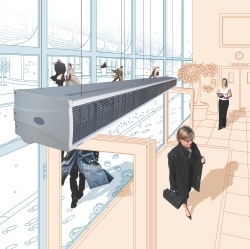The 5-month payback

With the tough Government target to reduce carbon emissions by 80% by 2050, improving the efficiency of commercial buildings remains key. Phil Chilton of Dimplex considers how the latest air-curtain technology can offer both environmental and financial benefits for businesses in the bid to cut carbon.
Considering that 40% of CO2 emissions in Europe come from commercial buildings, it is clear to see the potential of carbon-cutting initiatives such as the Carbon Reduction Commitment Energy Efficiency Scheme (CRC EES). And for businesses struggling to keep up with rising energy costs, they should not be seen as an inconvenience — more an opportunity to get one step ahead and save money too.
The latest air-curtain technology can offer commercial buildings improved energy efficiency and lower carbon emissions, offering a low-cost high-impact energy-saving solution which can help cut costly energy bills.
CRC EES was introduced in 2010 and is designed to reduce carbon emissions from larger users in the commercial sector. With up to 5000 businesses involved, representing 10% of UK carbon emissions, its target is to reduce emissions by 1.2 Mt by 2020.
Organisations which use more than 6000 MWh of electricity per year are required to measure and report their annual carbon emissions; under the scheme, they buy and sell carbon credits to match emissions.
The key point for businesses is the ability to sell credits if they make cuts to their own carbon output. With this in mind, there is now a growing emphasis on the careful specification and installation of products which can retain energy and save carbon — as well as offering businesses financial benefits in potentially cutting their CRC tax payments. Air curtains are perfectly positioned to achieve this and provide a cost-effective solution for businesses.
Despite the potential savings on offer, it is understandable that many businesses remain cautious when confronted with the need for substantial investment in new technologies. However, now is the time for those businesses to invest in energy-saving products and reap the benefits.
The latest high-efficiency products can not only help combat continued increases in energy bills but also exploit the financial incentives offered by the CRC EES to give considerable overall savings. For businesses, it means the initial investment can soon start paying back.

With excellent payback periods, an air curtain can be installed independently or in conjunction with other energy-saving measures to manage the internal environment of a building and improve efficiency.
Offering a low investment commitment and relative ease for engineers to install, air curtains use a fast-moving airstream to ‘seal the gap’ created by open doorways and allow buildings to hold on to treated air. Air curtains can save up to 30% on running costs, according to findings from the Carbon Trust and Bristol University, and a recent study by the Carbon Trust for ECA purposes showed that up to half of the 1.3 million commercial buildings in the UK could benefit from this technology.
Available in a variety of mounting heights and both surface-mounted and recessed styles, it is important for businesses to consider the needs of the building before planning an installation to ensure maximum return. When specified correctly, air curtains can offer a short payback time as low as five months which makes them a very attractive option - particularly for buildings with high footfall such as retail or leisure venues.
It is also important to remember that air curtains are not stand-alone technology and can be connected to low-cost control switches to further optimise their operation. For example, by connecting the air curtain to automated timers, passive infra-red sensors (PIRs) or to the building’s BMS control system, they can be carefully controlled to provide airstream coverage only when pre-determined, safeguarding the long-term running costs of the building. These simple yet effective control options ensure that the air curtains are working to maximum efficiency when, and only when, needed.
With easy installation, improved energy efficiency and reduced running and maintenance costs, air curtains provide a fast route to cutting carbon. And as carbon-reduction continues to play a big part in the UK’s energy policy, now is the time for organisations to reap the benefits.
Phil Chilton is commercial products manager for Dimplex.








